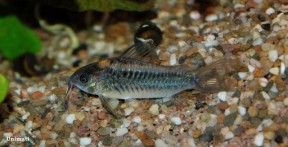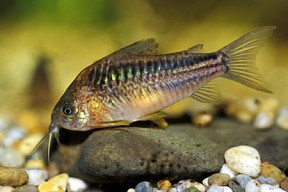Corydoras elegans
Elegant Cory
SynonymsTop ↑
Corydoras pestai Holly, 1940
Etymology
Corydoras: from the Ancient Greek κόρυς (korus), meaning ‘helmet’, and δορά (dora), meaning ‘skin, hide of an animal’, in allusion to the rows of bony plates on the flanks of genus members.
elegans: from the Latin elegans, meaning ‘fine, elegant, handsome’.
Classification
Order: Siluriformes Family: Callichthyidae
Distribution
This species is fairly widespread in the western Amazon basin and has been recorded in the Ríos Yavarí (Javary), Itaya, Nanay, Carahuayte, Tamaya, Ampiyacu, and Ucayali in Peru, the Ríos Aguarico and Napo in Ecuador, and the rio Solimões in Brazil.
Type locality is ‘Amazon River at Tefé, Amazonas, Brazil’.
Habitat
Forested streams with substrates of sand, mud, leaf litter, and fallen branches.
Maximum Standard Length
45 – 55 mm.
Maintenance
Ideally use a substrate of fine sand, although rounded gravel is an acceptable alternative provided it’s kept scrupulously clean.
Other décor is largely down to personal choice, but some cover should be provided to give the fish security.
Water Conditions
Temperature: 20 – 26 °C
pH: 6.0 – 7.5
Hardness: 18 – 268 ppm
Diet
Corydoras spp. are foraging omnivores and will accept most sinking dried foods, as well as small live and frozen varieties such as chironomid larvae (bloodworm), Tubifex, etc.
Feeding a varied diet will ensure the fish are in optimum condition.
Under no circumstances should they be expected to survive on ‘left-overs’ from other inhabitants of the aquarium or relied on to ‘clean’ the aquarium.
Behaviour and CompatibilityTop ↑
Peaceful, gregarious, and a popular inhabitant of the community set-up. Should be maintained in a group of at least 4-6 individuals.
Sexual Dimorphism
Females tend to grow larger, and sexually mature individuals are noticeably rounder and broader-bodied than males, especially when gravid. Males possess a more intense colour pattern than females, with a greater proportion of dark markings on the body and dorsal-fin.
Reproduction
Can be bred in a similar fashion to many other Corydoras species.
Use a ratio of 2 males per female if possible, and when the females are visibly full of eggs perform a large (50-70%) water change with cooler water, and increase oxygenation and flow in the tank. Repeat this daily until the fish spawn.
Eggs are normally deposited on the aquarium glass, but it’s recommended to provide alternatives in the form of fine-leaved vegetation or fine spawning mops.
Once spawning is complete either adults or eggs should be removed; the latter can usually be rolled gently up the glass with a finger.
The new container should contain the same water as the spawning tank and be similarly well-oxygenated. Most breeders add a few drops of methylene blue, or an alder cone or two at this point in order to prevent the eggs developing fungus.
Incubation is normally 3-4 days and once the fry have fully-absorbed their yolk sacs they are able to accept small live foods such as microworm, Artemia nauplii, etc.
They seem less susceptible to ailments when maintained over a thin layer of sand rather than in a bare-bottomed arrangement.
NotesTop ↑
This species is popular in the aquarium hobby and unlike the majority of congeners tends to spend a fair amount of time away from the substrate, often forming groups in midwater.
It has been placed in the unofficial ‘C. elegans group’, which contains a number of species exhibiting similarities in morphology and colour pattern, some of which remain unidentified in scientific terms. The group currently includes C. elegans, C. bilineatus, C. gracilis, C. nanus, C. napoensis, C. nijsseni, and C. undulatus, plus fishes of uncertain taxonomic status which have been assigned the ‘C’ numbers C041, C088, C089, C123, C126, and C132, plus the ‘CW’ numbers CW008, CW018, CW019, CW022, CW029, CW033, CW044, CW048, CW056, CW064, and CW085, respectively.
Phylogenetic studies suggest that the species Aspidoras pauciradiatus may also turn out to belong in this assemblage.
The genus Corydoras is among the largest catfish groups and currently contains over 150 valid species.
It is included in the family Callichthyidae, of which members are often referred to collectively as ‘armoured’ or ‘mailed’ catfishes group due to the presence of bony plates in place of scales on the body.
Their taxonomy can be confusing, and numerous undescribed species are also thought to exist.
Fish of unconfirmed identification entering the aquarium hobby are therefore typically assigned a ‘C‘ or ‘CW‘ number for purposes of reference and organisation.
They are facultative air breathers and possess a modified, highly vascularised intestine which has evolved to facilitate uptake of atmospheric oxygen and aid survival in oxygen-deprived environments. In the aquarium you’ll occasionally see them rising to the surface to take in gulps of air.
The stiffened pectoral-fin spines are capable of piercing human skin and a ‘sting’ can be very painful indeed, so care should be exercised when handling them.
It is thought that secretions from the axillary glands at the base of each spine may even be mildly toxic or venomous.
References
- Steindachner, F., 1876 - Sitzungsberichte der Kaiserlichen Akademie der Wissenschaften. Mathematisch-Naturwissenschaftliche Classe 74(1): 49-240
Ichthyologische Beiträge (V). - Ferraris, C. J., Jr., 2007 - Zootaxa 1418: 1-628
Checklist of catfishes, recent and fossil (Osteichthyes: Siluriformes), and catalogue of siluriform primary types. - Fuller, I. A. M., and H-G. Evers, 2005 - Verlag A.C.S. GmbH: 1-384
Identifying Corydoradinae Catfish. - Reis, R. E., S. O. Kullander, and C. J. Ferraris, Jr. (eds) , 2003 - EDIPUCRS, Porto Alegre: i-xi + 1-729
Check list of the freshwater fishes of South and Central America. CLOFFSCA.








